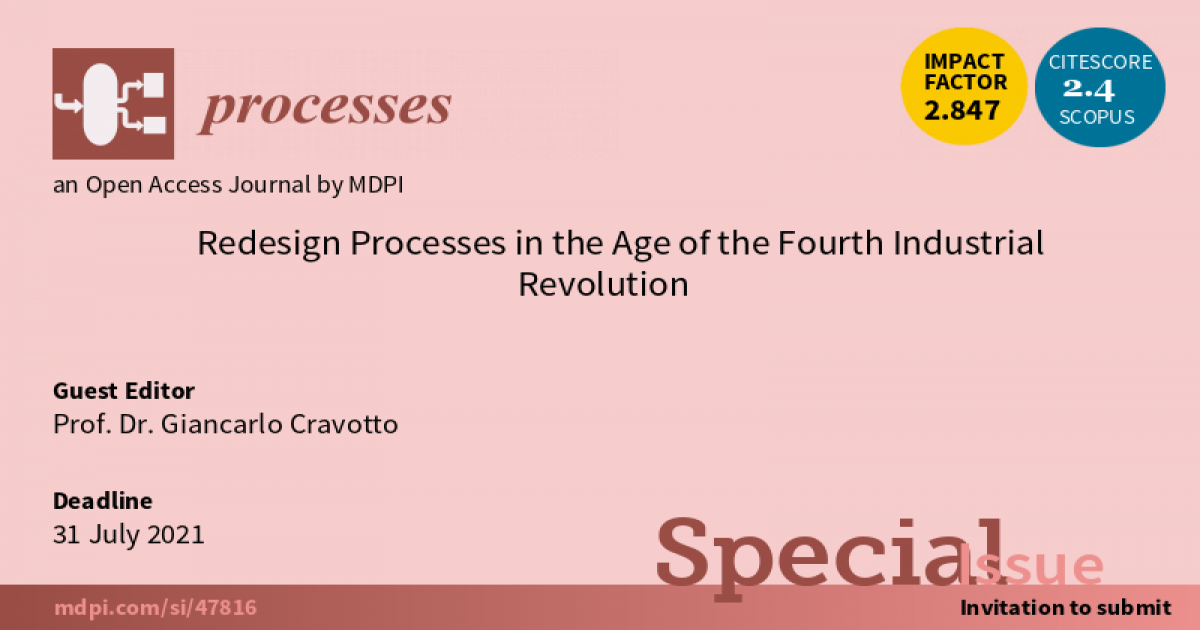Redesign Processes in the Age of the Fourth Industrial Revolution
A special issue of Processes (ISSN 2227-9717).
Deadline for manuscript submissions: closed (31 July 2021) | Viewed by 320400

Special Issue Editor
Interests: green chemistry; process intensification; green extraction; enabling technologies (ultrasound, microwaves, hydrodynamic cavitation, ball milling, flow chemistry); sustainable chemical processes
Special Issues, Collections and Topics in MDPI journals
Special Issue Information
Dear Colleagues,
This Special Issue, which is supported by the journal's Editorial Board, aims to highlight new comprehensive transdisciplinary models for the design of innovative processes in a range of Science and Technology fields. This holistic approach is reshaping current research and production strategies, which are too often confined to traditional, linear thought patterns. The merging of academic and industrial experience with economic and environmental knowledge will help laboratories, industries, and businesses achieve sustainable growth. We are expecting papers with the power to disrupt and innovate, which exploit combinations of technologies to shape our future processes.
Prof. Dr. Giancarlo Cravotto
Guest Editor
Manuscript Submission Information
Manuscripts should be submitted online at www.mdpi.com by registering and logging in to this website. Once you are registered, click here to go to the submission form. Manuscripts can be submitted until the deadline. All submissions that pass pre-check are peer-reviewed. Accepted papers will be published continuously in the journal (as soon as accepted) and will be listed together on the special issue website. Research articles, review articles as well as short communications are invited. For planned papers, a title and short abstract (about 250 words) can be sent to the Editorial Office for assessment.
Submitted manuscripts should not have been published previously, nor be under consideration for publication elsewhere (except conference proceedings papers). All manuscripts are thoroughly refereed through a single-blind peer-review process. A guide for authors and other relevant information for submission of manuscripts is available on the Instructions for Authors page. Processes is an international peer-reviewed open access semimonthly journal published by MDPI.
Please visit the Instructions for Authors page before submitting a manuscript. The Article Processing Charge (APC) for publication in this open access journal is 2400 CHF (Swiss Francs). Submitted papers should be well formatted and use good English. Authors may use MDPI's English editing service prior to publication or during author revisions.
Benefits of Publishing in a Special Issue
- Ease of navigation: Grouping papers by topic helps scholars navigate broad scope journals more efficiently.
- Greater discoverability: Special Issues support the reach and impact of scientific research. Articles in Special Issues are more discoverable and cited more frequently.
- Expansion of research network: Special Issues facilitate connections among authors, fostering scientific collaborations.
- External promotion: Articles in Special Issues are often promoted through the journal's social media, increasing their visibility.
- Reprint: MDPI Books provides the opportunity to republish successful Special Issues in book format, both online and in print.
Further information on MDPI's Special Issue policies can be found here.





